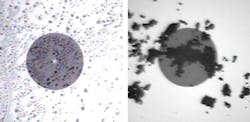Minor MPO/MTP endface contaminants under PAM4 modulation can greatly erode 200G/400G link budgets
By MAURY WOOD, AFL -- While structured cabling using multi-fiber connectors such as MPO/MTP have been in use in enterprise data centers for many years, the prevalence of this connector type continues to steeply increase.
This is due to the confluence of commercial dynamics (including the apparently insatiable consumer demand for broadband data services) and technical dynamics (including the need for parallel full-duplex lanes of transceiver optics for performance purposes). Concurrently, the relentless drive for high optical network operating efficiency, and minimal lost productivity, is leading to an expanding desire, particularly by hyperscale network operators, for 100% microscopic inspection of their infrastructure connectivity.
AFL estimates there are more than 10 million MPO/MTP connectors in use across the world today, with more than 1 million forecasted to be fielded in 2019. An MPO connector market compound annual growth rate (CAGR) of at least 10% is expected to sustain for the next five years.
See Also: Testing MPO and evolving data center standards
As all communications engineers and technicians are aware, nearly all link failures occur at points of connection, and very rarely across unbroken network spans. At the same time, the signal modulation technology that underlies the new short-reach 200G/400G optical Ethernet standard reduces the available link budget in high-bandwidth datacom applications – making the operational need for immaculate connector endfaces all the more imperative.
Data centers typically rapidly adopt the latest networking technologies as their operators seek a competitive performance edge. The new IEEE 802.3bs 200G/400G Ethernet standard specifies the use of PAM4 modulation, a departure from the older non-return to zero (NRZ) modulation method. PAM4 provides higher spectral efficiency, but because it encodes two bits (four states) into the same carrier signal dynamic range as NRZ (which encodes one bit or two states), PAM4 requires about 9.6 dB more link optical signal-to-noise ratio than NRZ to maintain the same symbol error rate statistics (see Figure 1).
Figure 1. Example PAM4 eye diagram showing the four encoding states. (Photo courtesy of Keysight Technologies)
While this physical layer transmission technology change may initially seem unrelated to optical connector cleanliness, there is a distinct and important link. In 10G, 40G, and 100G systems using NRZ modulation, a contaminated connector endface may cause optical losses that can be largely ignored on the short-reach cabling common in data centers.
However, in 200G and 400G systems using PAM4 modulation, the same level of endface contamination will erode a greatly reduced link budget margin, driving optical network technologists to demand pristine connector endfaces. Best-practice connector cleaning and inspection procedures will become essential to maintain the highest levels of performance and reliability.

